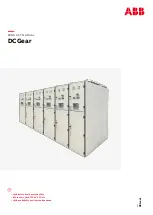
3.3 Coupling of the section of electrical panel
Danger
High voltage
Danger to life, severe personal injury or
property damage.
The tests involve the use of high voltage.
Perform these tests in conditions of safety.
Use only qualified personnel.
The coupling of the different sections that make
up the electric panel to be executed (fig. 3.3a)
according to the following instructions.
•
Check that the supporting girders are well aligned
and coplanar and that there are no unevenness
of any kind including in the spaces needed for
the handling of the equipment on trolley
•
Place the insulation panels in each compartment,
considering that should respect to the dimensions
of the panels of 5 mm for all sides
•
Arrange the slices in the final position in the
order of composition the panel making sure
that the holes on the structure coincide with
the holes (in the case) on the support surface
•
Check that the sides of adjacent section are
perfectly fitting for the entire height of the
compartment, then secure each compartment
to the support surface, temporarily secure the
structure to the support surface
11
I N S T A L L A T I O N
•
Connect adjacent sections inserting the screws
M8 supplied in the holes drilled on the side of
each compartment. When required by the
technical documentation assemble the kit of
isolation between compartments, placing the
crosspieces and using insulating washers
(fig. 3.3a)
•
Tighten the bolts
•
Connecting bars between adjacent sections and
the ground conductors of the various sections,
as follows
•
Remove the sheet of segregation, if necessary
•
Clean with alcohol and apply contact grease type
the contact surfaces of the bars MOLYCOTE
7439 CU PLUS or similar
•
Insert the bars or junction, taking care that
the protrusion of the screws does not reduce
the clearances (fig. 3.3b)
•
Tightening the bolts follow the torque values
shown in Table 2
•
Replace all the plates of segregation previously
removed
•
Check the insulation of the power circuit (positive
and negative barriers) than the mass of the
framework, the insulation between the structure
of the framework and the support surface
(floating floor basement) and the isolation
between adjacent compartment (if provided).
Using a Megger 1000 V the measured resistance
must be greater than 80 MΩ











































